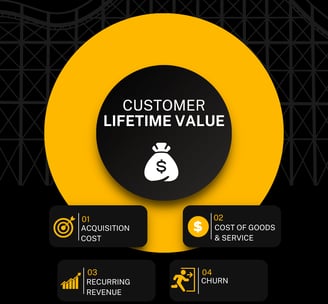What’s in a CLV? Understanding Customer Lifetime Value
Customer Lifetime Value (CLV) measures a customer’s total worth to your business. It depends on acquisition costs, recurring revenue, cost to serve, and churn rate. To maximize CLV, businesses must reduce CAC, increase retention, optimize pricing, and lower service costs. Learn how ProfitCoaster can help you unlock higher CLV and profits.


Customer Lifetime Value (CLV) is one of the most important metrics for any subscription business. It tells you how much revenue a customer is expected to generate over their entire relationship with your business. But CLV isn’t just about revenue—it’s about profitability.
A business with high CLV isn’t just good at acquiring customers; it’s great at keeping them, maximizing their value, and serving them efficiently. Let’s break down the key factors that go into CLV and how they impact your bottom line.
1. One-Time Acquisition Costs: The Price of Getting a Customer
Every customer comes with an upfront cost. Whether it's digital advertising, sales commissions, or discounts to attract new subscribers, these expenses add up. This is your Customer Acquisition Cost (CAC)—and the higher it is, the longer it takes to turn a profit.
Why it matters: If you’re spending too much to acquire customers who don’t stick around, your CLV suffers.
How to improve: Focus on attracting high-intent customers and optimizing your CAC-to-CLV ratio rather than just lowering acquisition costs.
2. Recurring Revenue: The Foundation of a Strong CLV
The power of a subscription business lies in predictable, repeatable revenue. Every month a customer stays subscribed, they contribute to your CLV. The longer they stay, the more valuable they become.
Why it matters: A one-time purchase business has to keep finding new customers, but a subscription model builds value over time.
How to improve: Encourage upsells, add-ons, and premium plans to maximize revenue per customer.
3. Cost to Serve: The Expense of Keeping Customers Happy
Not all revenue is profit—some customers cost more to serve than others. This includes customer support, product usage costs, and fulfillment expenses. The more efficiently you serve customers, the more of their revenue turns into profit.
Why it matters: If servicing a customer costs too much, even high revenue won’t lead to profitability.
How to improve: Reduce costs with better onboarding, automation, and self-service options to ensure customers stay happy without driving up expenses.
4. Churn Rate: The Silent Killer of CLV
Churn is the percentage of customers who cancel their subscriptions over a given period. Even if you have strong revenue, a high churn rate will limit CLV and profitability.
Why it matters: If customers leave too soon, you don’t have enough time to recover acquisition costs or generate profit.
How to improve: Focus on retention strategies, personalized engagement, and reducing friction points that cause cancellations.
Optimizing CLV with ProfitCoaster
Understanding CLV is just the first step—optimizing it is where the real profit lies. At ProfitCoaster, we help subscription businesses:
✔ Reduce CAC while improving customer quality
✔ Maximize recurring revenue through smart pricing & upsells
✔ Lower service costs without sacrificing customer experience
✔ Minimize churn and improve retention strategies
If you're ready to increase profitability and build a long-term, sustainable subscription business, let’s talk.
Contact ProfitCoaster today to start optimizing your CLV!